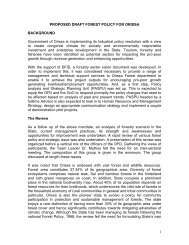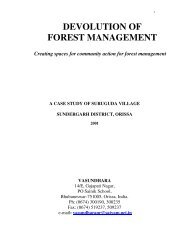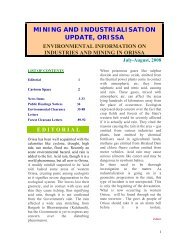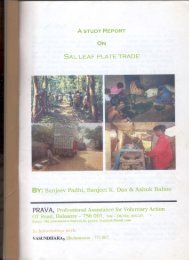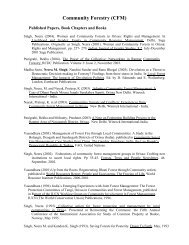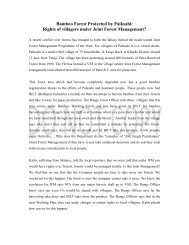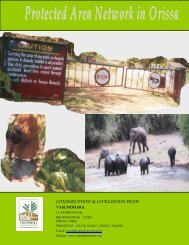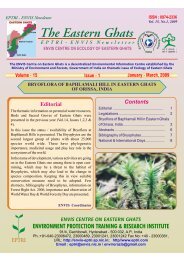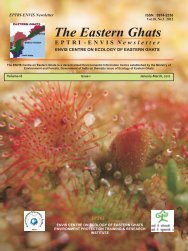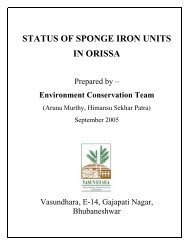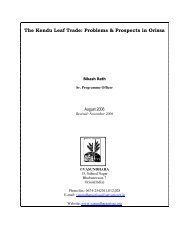Bamboo in Orissa: Trade and Livelihood Perspective - Vasundhara
Bamboo in Orissa: Trade and Livelihood Perspective - Vasundhara
Bamboo in Orissa: Trade and Livelihood Perspective - Vasundhara
You also want an ePaper? Increase the reach of your titles
YUMPU automatically turns print PDFs into web optimized ePapers that Google loves.
All rights reserved by VASUNDHARA(www.vasundharaorissa.org). For any clarification, contact author at sunlit1968@yahoo.co.<strong>in</strong><br />
Paper mill<br />
Requirement <strong>in</strong> ton<br />
Straw Products Ltd.(JK Paper) 117600<br />
Orient Paper Mill 182400<br />
TP Mills(Chowdwar) 48000<br />
SEWA (Jeypore) 80000<br />
(Source:OFDC)<br />
Estimation by OFDC <strong>in</strong> 1997-98 suggested the requirement of raw materials <strong>in</strong> the four<br />
units as under:<br />
Paper mill<br />
Requirement <strong>in</strong> ton<br />
Straw Products Ltd.(JK Paper) 117600<br />
Orient Paper Mill 182400<br />
BILT(Chowdwar) 54950<br />
BILT(SEWA) 58136<br />
(Source: Agenda notes for the meet<strong>in</strong>g of the Emp. Committee for 1997-98 crop)<br />
The estimation furnished <strong>in</strong> the above table was actually based on the pr<strong>in</strong>ciple that per ton<br />
of paper produced, 2.8 MT of raw material would be required. Accord<strong>in</strong>gly, the<br />
requirement was estimated on the basis of the paper production <strong>in</strong> <strong>in</strong>dividual mills dur<strong>in</strong>g<br />
1996-97. For <strong>in</strong>stance, JK Crop produced 75984 tons of paper <strong>in</strong> 1996-97, hence @2.8<br />
times of this figure, its raw material requirement was estimated to be 212755 MT. It may<br />
be noted here that dur<strong>in</strong>g early '90s, the adopted proportion of raw material to paper was<br />
2.5:1(vide Proceed<strong>in</strong>gs of the Emp. Committee meet<strong>in</strong>g on 25.10.94).<br />
However, practically there were several variations to the above estimations. If bamboo is<br />
taken as such, then the proportion of raw material to paper would be 3.67:1. This is for<br />
naturally dry bamboo(salia) hav<strong>in</strong>g about 20% moisture. This bamboo is mach<strong>in</strong>e-dried <strong>in</strong><br />
the paper mills to turn <strong>in</strong>to what is known as 'bone-dry'(BD) bamboo; <strong>and</strong> <strong>in</strong> the case of<br />
BD bamboo the proportion changes to 2.2:1.<br />
Paper mills used wood s<strong>in</strong>ce long, but the ratio of bamboo <strong>and</strong> wood was about 90:10.<br />
Production <strong>in</strong> <strong>Orissa</strong> was not sufficient to meet the requirement of the mills. For <strong>in</strong>stance,<br />
for the 1997-98 crop, 2.53 lakh MT of bamboo was proposed to be distributed to the four<br />
paper mills aga<strong>in</strong>st an estimated raw material requirement of 4.665 MT. The practice<br />
dur<strong>in</strong>g mid-'90s was that the allocation to <strong>in</strong>dividual mills was limited practically to about<br />
50% of their raw material requirement. This k<strong>in</strong>d of shortage over the years, as well as the<br />
price of bamboo forced paper mills to adopt commercially viable technology so that<br />
dependency on bamboo could be reduced to m<strong>in</strong>imum. Dur<strong>in</strong>g '90s the consumption ratio<br />
of bamboo <strong>and</strong> hardwood changed to 50:50 <strong>in</strong> some paper mills, <strong>and</strong> by 2003, it changed to<br />
20:80 <strong>in</strong> cases like JK Paper. This company had a requirement of 117600 MT of bamboo<br />
<strong>and</strong> 50400 MT of hardwood <strong>in</strong> 1989, which <strong>in</strong>creased to 127400 MT <strong>and</strong> 54600 MT<br />
44



